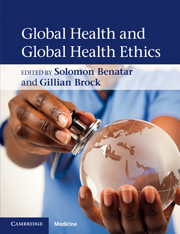Book contents
- Frontmatter
- Contents
- List of contributors
- Introduction
- Section 1 Global health, definitions and descriptions
- 1 What is global health?
- 2 The state of global health in a radically unequal world: patterns and prospects
- 3 Addressing the societal determinants of health: the key global health ethics imperative of our times
- 4 Gender and global health: inequality and differences
- 5 Health systems and health
- Section 2 Global health ethics, responsibilities and justice: some central issues
- Section 3 Analyzing some reasons for poor health
- Section 4 Shaping the future
- Index
- References
4 - Gender and global health: inequality and differences
Published online by Cambridge University Press: 01 March 2011
- Frontmatter
- Contents
- List of contributors
- Introduction
- Section 1 Global health, definitions and descriptions
- 1 What is global health?
- 2 The state of global health in a radically unequal world: patterns and prospects
- 3 Addressing the societal determinants of health: the key global health ethics imperative of our times
- 4 Gender and global health: inequality and differences
- 5 Health systems and health
- Section 2 Global health ethics, responsibilities and justice: some central issues
- Section 3 Analyzing some reasons for poor health
- Section 4 Shaping the future
- Index
- References
Summary
Introduction
Gender equity and gender equality appear increasingly often in the health policies and mission statements of national governments and international organizations. These concepts are found not only in the more obvious locations such as the World Health Organization (WHO), United Nations Development Program (UNDP) or the United Nations Population Fund (UNFPA) but also in settings as apparently unlikely as the World Bank. But do we really know what these terms mean and how they could be achieved? Indeed would we recognize them if we saw them?
This chapter will explore these issues from a number of different perspectives. First it will spell out the differences between male and female patterns of health and illness. Second it will offer the conceptual tools necessary for understanding them. This will involve a clarification of the distinction between biological sex and social gender as well as an exploration of their inter-relationships. Given this background we can then explore the differences between equity and equality in the context of gender and health policy.
Men and women: patterns of health and illness
Any attempt to compare the health and well-being of women and men is faced with considerable challenges. All the available data have limitations in terms of what is counted, and how accurately and inclusive these statistics are. These limitations are greatest in the poorest parts of the world. Despite these problems such data offer a useful indication of various health inequalities, including those between men and women.
- Type
- Chapter
- Information
- Global Health and Global Health Ethics , pp. 53 - 62Publisher: Cambridge University PressPrint publication year: 2011
References
- 3
- Cited by



